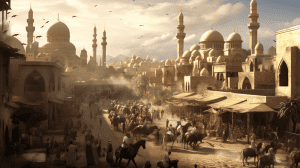The ruler of the kingdom of Great Zimbabwe was named Munhumutapa. This ancient African kingdom existed between the 11th and 15th centuries CE and was revered for its stone architecture. The city of Great Zimbabwe was the centre of politics, economics, and culture. Munhumutapa became the most powerful leader during the peak of the kingdom in the 14th century.
Historians are unsure about the ancestry of Munhumutapa, but they believe his ancestors were the Shona people, as they are the dominant ethnic group in the area today. The rise of Munhumutapa was due to his control of gold mines in the region, which made the kingdom wealthy through trade and commerce. The kingdom also controlled the trade of valuable goods such as ivory.

The legacy of Munhumutapa
In the 14th century, the kingdom reached its peak under the rule of Munhumutapa, as he extended his control across a large area in southern Africa, making the city of Great Zimbabwe a centre of economics, politics, and culture.
Munhumutapa’s rule was characterised by a centralisation of power, enabling him to maintain control over the vast territory under his rule. The king was responsible for maintaining peace and the administration of justice. He was a semi-divine figure, and his rule was justified by religious beliefs.
Under the rule of Munhumutapa, the kingdom had a complex system of administration that was divided into provinces, each ruled by a governor chosen by the king. This system enabled the kingdom to control the population of the provinces as well as resources, ensuring a stable and efficient rule. The kingdom had a strong tradition of metalworking and produced a wide range of items such as weapons, jewellery, and religious objects. The kingdom was also known for its great achievement, mainly the stone architecture known as the Great Enclosure. This is considered to be one of the most impressive architectural achievements in pre-colonial Africa.
By the 15th century, Great Zimbabwe declined, despite the ruler’s efforts to maintain stability and prosperity. There are a few factors that contributed to the decline of the kingdom, including conflicts with neighbouring kingdoms, internal power struggles, factionalism, overpopulation, and environmental degradation. The Portuguese also established a presence in the region and attempted to take control of the gold mines, but the locals fought back. The Portuguese also brought new technologies and opened different trade routes, which affected the economy of the kingdom.

People still lived in Great Zimbabwe up until the 16th century, but the city was eventually abandoned, and the ruins were left to decay. The legacy of the kingdom is still felt and appreciated today, as the ruins of Great Zimbabwe are now a UNESCO World Heritage Site. It is considered to be of great historical and cultural significance to the people of Zimbabwe, reminding them of the achievements of the kingdom before Africa was colonized. The kingdom is still being studied by scholars and researchers to gain a better understanding of the history and culture of the region. In conclusion, the kingdom of Great Zimbabwe was an important pre-colonial state in Southern Africa, with a powerful leader and impressive achievements in stone architecture, metalworking and administration.
Despite the decline of the kingdom, the legacy of Great Zimbabwe and its leader Munhumutapa lives on. The ruins of the city are a testament to the advanced civilisation that existed in southern Africa before the arrival of European colonisers. Visitors to the UNESCO World Heritage Site can still see the impressive stone architecture of the Great Enclosure, and the intricate metalworking that was a hallmark of the kingdom. The kingdom’s political, economic, and cultural influence in the region is still evident today, and the study of its history continues to provide valuable insights into pre-colonial Africa.
Munhumutapa, as the leader of the kingdom, played a significant role in the rise and decline of Great Zimbabwe. He was able to centralise power and control the gold mines, making the kingdom wealthy through trade and commerce. He also had a cosmopolitan court and maintained control over a vast territory. His rule was characterised by peace and the administration of justice, and he was considered a semi-divine figure.
In conclusion, the kingdom of Great Zimbabwe and its leader Munhumutapa were an important part of southern Africa’s history. The kingdom’s impressive stone architecture, metalworking, and administration system have left a lasting legacy and continue to be studied and appreciated today. The ruins of the city serve as a reminder of the advanced civilisation that existed in southern Africa before the arrival of European colonisers and a source of inspiration for the people of Zimbabwe.
Related Posts
Sources
Mudenge, S. I. G. Mutapa Politics: A Political History of Munhumutapa c. 1400-1902. Harare, Zimbabwe Publishing House; London, James Currey, 1988. pp. xxix, 420. Journal of African History, vol. 31, no. 3 (1990): 527-28. https://www.cambridge.org/core/journals/journal-of-african-history/article/abs/mutapa-politics-a-political-history-of-munhumutapa-c-14001902-by-s-i-g-mudenge-harare-zimbabwe-publishing-house-london-james-currey-1988-pp-xxix-420-1195-paperback/661A738302B9819D3CA9F3D155E8B091.






